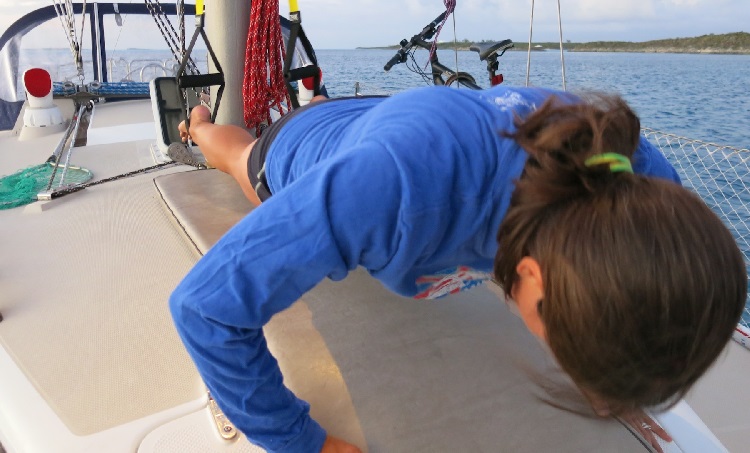Resolve To Improve Your Sailing Fitness
Ah, the New Year! The days start getting longer, but there’s still more darkness than light. The glow of sailing season is visible on the horizon, but it’s faint. This is actually the perfect time to start getting your body tuned up for the upcoming season. It’s like spring boat prep but you’re the boat, it’ll take longer, and there might be a little more cursing.

It’s worth noting that a focus on fitness isn’t just for racers. Any sailor that doesn’t have push-button controls (aka - cheaters) has to pull on a line, grind a winch, or walk a deck that’s bouncing around. None of those are “normal” things to do, so the risk of injury is real. A little time invested now can ensure that your sailing season isn’t shortened by a fluke injury -- ice should be in your cocktail, not in a bag on your back.
So here are a few ideas for getting yourself into a better place physically for the upcoming year of sailing. We’ll be focusing on four specific focus areas: aerobic fitness, stretching, core exercises, and weight/strength training.
Disclaimer
This isn’t one of those lawyer-y disclaimers. Well, okay -- consult with a professional trainer to make sure you’re doing things right if you ever have any questions. That actually is kind of important.
It's really more of a reality check. There is no such thing as “the perfect sailor’s workout”. We’re highlighting some focus areas and providing general targets but ultimately the best “sailors workout” is one that you’ll actually do. Physical fitness isn't always a piece of the puzzle that sailors or racers think about and this series is meant to "start the conversation" for you.
Be smart and be careful about what you choose to do!
Aerobic Fitness
We’re leading off with aerobic fitness and any discussion about getting prepped for sailing should probably start with it.

You’ve probably experienced this on a windy day: you’re pulling down a spinnaker or grinding like crazy and find yourself breathing hard. Maybe you start to taste pennies in your mouth (or that’s just a personal experience). Your lungs begin to burn and you start to feel a heavy fatigue in your muscles. You finish up whatever you’re doing, hit the rail, and work to catch your breath before the next maneuver.
To lessen that lung burn, lower the muscle fatigue, and bring that recharge time on the rail down, think about adopting an aerobic (aka: cardio) workout. The rough idea behind a cardio routine is to improve your stamina during moments of peak exertion and to increase the ability of your body to deliver more oxygen to cells in your muscles. Get more oxygen to your muscles and they should work more efficiently so you experience less fatigue.
Benefits
The American College of Sports Medicine, Department of Health and Human Services, World Health Organization, and basically everyone that want people to be healthy all agree that we should be getting in at least 150 minutes of moderate intensity aerobic physical activity each week. That covers activities like a brisk walk, light jogging, or swimming.
You can halve that number to 75 minutes if you aim for vigorous-intensity aerobic physical activity. When it comes to vigorous-intensity activities, we’re talking running, biking at a solid clip, rowing, etc -- anything where you’re working hard enough that it’s tough to talk while doing it. The vigorous-intensity activity is where you’ll start to make real gains with your aerobic fitness.
Starting from Scratch?
If the Winter has been winning and you haven’t been all that close to the 150 minutes/week target, don’t worry. Aim for 30 minutes of walking/jogging/biking, four to five times a week. Yes, that might sound like a lot, especially if you keep a busy schedule, but don’t be afraid to break that up into three sessions of 10 minutes a day at first. As you get stronger and can find more time, make it two sessions of 15 minutes and work up to a non-stop 30 minutes.
After you reach that half-hour mark, try to slowly increase the your speed -- be careful here and increase in small increments. Small changes can have a big effect and we’re trying to prevent injury here. If you can swing the extra time, add on a few minutes too -- you really start to get benefits from any extra time beyond a half-hour.
Already At or Beyond Targets?
If you’re already well into the vigorous exercise target range, or it’s in the rearview, that’s great. Maybe you’re looking for a different challenge?

The boys on Oracle Team USA had a killer workout using a rowing machine as they prepped for the last America’s Cup. They would do a 20-minute timed workout that simulated grinding two upwind and two downwind legs, but they also mixed in getting off the rowing machine at set times and sprinting about 20’ to simulate tacks. You can get the details here but it looks like a burner. Then again, you never saw any of the grinders on OTUSA tapping out in the middle of a race!
Next up -- core exercises!




